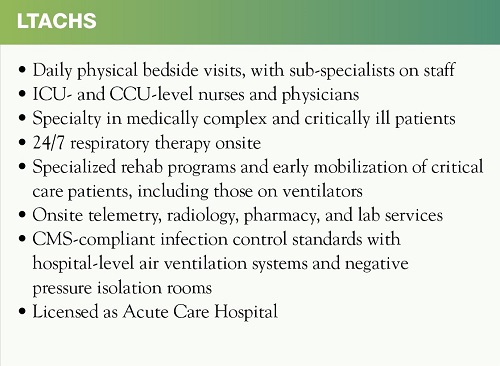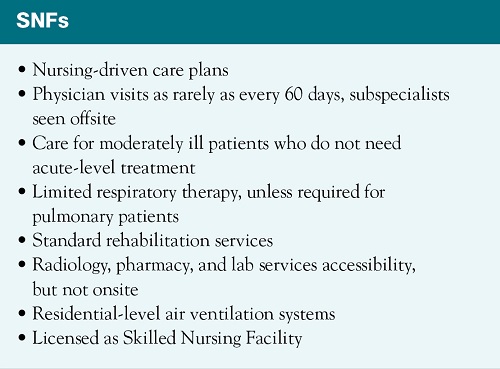As value-based care continues to grow in importance for the nation’s health systems, so will efforts to improve outcomes and lower total cost of care.
While many patients leaving the hospital are able to fully recover at a skilled nursing facility (SNF) or at home, a small percentage of them requires continued acute care. Without the proper level of treatment and access to specialized physicians and services, these patients are more likely to readmit to the hospital, thereby increasing total cost.
This whitepaper outlines the distinction in clinical capabilities of long-term acute care hospitals (LTACHs) and SNFs and evaluates the characteristics that make LTACHs the ideal recovery setting for medically complex and critically ill patients leaving an ICU or med-surg unit.
Quick View: Differences between LTACHs and SNFs


Hospital-level staffing allows LTACHs to treat the most medically complex patients
One major differentiator between LTACHs and lower levels of care such as SNFs is staffing. At an LTACH, physicians, many of whom are sub-specialists in areas such as pulmonology, infectious disease, and neurology, provide patients with daily oversight. This contrasts with SNFs where visits from a physician are often much less frequent.
Furthermore, LTACH physicians, along with ICU- and CCU-level clinicians in interdisciplinary care teams, are trained to treat medically complex patients who come to an LTACH with an average of six comorbidities.1 Despite caring for a more complex patient population, LTACHs were still half as likely as SNFs to readmit a patient to an STACH.2
LTACHs also provide 24/7 respiratory therapist coverage which allows them to care for patients with critical pulmonary conditions, mechanical ventilation, and tracheostomies.
LTACH expertise in treating medically complex patients has thus played a critical role in reducing costly readmissions for high-risk patients.
Specialized rehabilitation therapists at LTACHs work alongside acute-care clinicians to advance recovery
Unlike in lower levels of care such as SNFs, rehabilitation services at an LTACH are integrated with acute care to help patients with medically complex conditions achieve the fastest and most complete recovery possible. These patients benefit from medical care provided by physicians paired with specialized rehabilitation from physical, respiratory, and occupational therapists, as well as speech-language pathologists.
LTACH respiratory therapists are also able to liberate patients from mechanical ventilators, which can have considerable advantages. One study found that protocol-driven ventilator weaning led by respiratory therapists at LTACHs can significantly decrease time on ventilator, mortality, and cost of care.3
As such, partnership with LTACHs can help certain patients fully recover more quickly and can lower total cost of care.
LTACH settings are constructed for high-quality care and efficiency
Licensed as acute care hospitals, LTACHs, unlike lower levels of care, are equipped with on-site laboratories, radiology, and dialysis which reduce the need for outpatient services. LTACHs are therefore able to increase efficiency and limit potential setbacks that patients may experience as a result of being transported between facilities.
LTACHs also feature negative pressure isolation rooms that allow them to reduce the spread of highly contagious viruses and bacteria. Infection control standards, overseen by a specialized Infection Prevention Nurse, also comply with the requirements of the Centers for Medicare and Medicaid Services (CMS) for general acute care hospital licensing.
These protocols are unmatched by most other post-acute care providers. During the pandemic, lower levels of care such as SNFs that had admitted COVID-19 patients faced challenges in preventing spread of the disease to other residents, while LTACHs largely contained infection within COVID-dedicated units or hospitals.4
Infection prevention is critical both for improving outcomes of patients in the hospital, as well as maintaining the health and safety of staff which is required for efficient hospital operation.
How Partnership with Kindred Can Help
As a pioneer in the long-term acute care hospital industry, Kindred Healthcare has worked with patients and health systems across the country for more than three decades. As a commitment to continued improvement in quality of care, Kindred is achieving disease-specific certifications from The Joint Commission in Sepsis and Respiratory Failure in all its hospitals.
Furthermore, innovations such as the Move Early Mobility Program which aims to incorporate mobilization as early as is safe, have resulted in improved patient outcomes.
Kindred Hospitals are committed to an innovative approach to contracting. Health plan partnerships are customized by product and can be built on DRG rates, negotiated per diem rates, or within value-based agreements.
Visit kindredmanagedcare.com to request a conversation about how Kindred Hospital’s level of services can help manage your critically complex patients.
References:
1. https://www.ncbi.nlm.nih.gov/pmc/articles/PMC3094575/
2. https://atiadvisory.com/role-of-ltac-hospitals-in-covid-19-pandemic
3. https://www.ncbi.nlm.nih.gov/pmc/articles/PMC7774095/
4. https://atiadvisory.com/role-of-ltac-hospitals-in-covid-19-pandemic
Dr. Sean Muldoon, SVP, CMO for Kindred Hospitals, oversees clinical care oversight, medical staff affairs, and strategic relationships.
